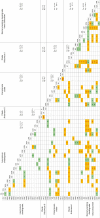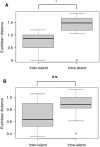Inter- and intra-island speciation and their morphological and ecological correlates in Aeonium (Crassulaceae), a species-rich Macaronesian radiation
- PMID: 36821492
- PMCID: PMC10147336
- DOI: 10.1093/aob/mcad033
Inter- and intra-island speciation and their morphological and ecological correlates in Aeonium (Crassulaceae), a species-rich Macaronesian radiation
Abstract
Background and aims: The most species-rich and ecologically diverse plant radiation on the Canary Islands is the Aeonium alliance (Crassulaceae). In island radiations like this, speciation can take place either within islands or following dispersal between islands. Aiming at quantifying intra- and inter-island speciation events in the evolution of Aeonium, and exploring their consequences, we hypothesized that (1) intra-island diversification resulted in stronger ecological divergence of sister lineages, and that (2) taxa on islands with a longer history of habitation by Aeonium show stronger ecological differentiation and produce fewer natural hybrids.
Methods: We studied the biogeographical and ecological setting of diversification processes in Aeonium with a fully sampled and dated phylogeny inferred using a ddRADseq approach. Ancestral areas and biogeographical events were reconstructed in BioGeoBEARS. Eleven morphological characters and three habitat characteristics were taken into account to quantify the morphological and ecological divergence between sister lineages. A co-occurrence matrix of all Aeonium taxa is presented to assess the spatial separation of taxa on each island.
Key results: We found intra- and inter-island diversification events in almost equal numbers. In lineages that diversified within single islands, morphological and ecological divergence was more pronounced than in lineages derived from inter-island diversification, but only the difference in morphological divergence was significant. Those islands with the longest history of habitation by Aeonium had the lowest percentages of co-occurring and hybridizing taxon pairs compared with islands where Aeonium arrived later.
Conclusions: Our findings illustrate the importance of both inter- and intra-island speciation, the latter of which is potentially sympatric speciation. Speciation on the same island entailed significantly higher levels of morphological divergence compared with inter-island speciation, but ecological divergence was not significantly different. Longer periods of shared island habitation resulted in the evolution of a higher degree of spatial separation and stronger reproductive barriers.
Keywords: Aeonium; Canary Islands; ancestral area reconstruction; biogeographical stochastic mapping; diversification; island biogeography; molecular dating.
© The Author(s) 2023. Published by Oxford University Press on behalf of the Annals of Botany Company.
Figures








Similar articles
-
Islands Promote Diversification of the Silvereye Species Complex: A Phylogenomic Analysis of a Great Speciator.Mol Ecol. 2025 Jul;34(14):e17830. doi: 10.1111/mec.17830. Epub 2025 Jun 11. Mol Ecol. 2025. PMID: 40497404 Free PMC article.
-
Integrating plot-based methods for monitoring biodiversity in island habitats under the scope of BIODIVERSA + project BioMonI: Tree monitoring in Terceira, Tenerife and Réunion Islands.Biodivers Data J. 2025 Jun 23;13:e158423. doi: 10.3897/BDJ.13.e158423. eCollection 2025. Biodivers Data J. 2025. PMID: 40708791 Free PMC article.
-
Systemic pharmacological treatments for chronic plaque psoriasis: a network meta-analysis.Cochrane Database Syst Rev. 2021 Apr 19;4(4):CD011535. doi: 10.1002/14651858.CD011535.pub4. Cochrane Database Syst Rev. 2021. Update in: Cochrane Database Syst Rev. 2022 May 23;5:CD011535. doi: 10.1002/14651858.CD011535.pub5. PMID: 33871055 Free PMC article. Updated.
-
Adefovir dipivoxil and pegylated interferon alfa-2a for the treatment of chronic hepatitis B: a systematic review and economic evaluation.Health Technol Assess. 2006 Aug;10(28):iii-iv, xi-xiv, 1-183. doi: 10.3310/hta10280. Health Technol Assess. 2006. PMID: 16904047
-
Signs and symptoms to determine if a patient presenting in primary care or hospital outpatient settings has COVID-19.Cochrane Database Syst Rev. 2022 May 20;5(5):CD013665. doi: 10.1002/14651858.CD013665.pub3. Cochrane Database Syst Rev. 2022. PMID: 35593186 Free PMC article.
Cited by
-
Transition Processes in Technological Systems: Inspiration from Processes in Biological Evolution.Biomimetics (Basel). 2025 Jun 16;10(6):406. doi: 10.3390/biomimetics10060406. Biomimetics (Basel). 2025. PMID: 40558375 Free PMC article.
-
Atmospheric CO2 decline and the timing of CAM plant evolution.Ann Bot. 2023 Nov 25;132(4):753-770. doi: 10.1093/aob/mcad122. Ann Bot. 2023. PMID: 37642245 Free PMC article.
-
A new phylogenetic framework for the genus Kalanchoe (Crassulaceae) and implications for infrageneric classification.Ann Bot. 2025 Aug 16;135(7):1311-1328. doi: 10.1093/aob/mcaf004. Ann Bot. 2025. PMID: 39827087 Free PMC article.
-
Speciation happens in company - not in isolation.NPJ Biodivers. 2024 Jul 5;3(1):16. doi: 10.1038/s44185-024-00047-5. NPJ Biodivers. 2024. PMID: 39242908 Free PMC article. Review.
References
-
- Albaladejo RG, Martín-Hernanz S, Reyes-Betancort JA, Santos-Guerra A, Olangua-Corral M, Aparicio A.. 2021. Reconstruction of the spatio-temporal diversification and ecological niche evolution of Helianthemum (Cistaceae) in the Canary Islands using genotyping-by-sequencing data. Annals of Botany 127: 597–611. - PMC - PubMed
-
- Anderson CL, Channing A, Zamuner AB.. 2009. Life, death and fossilization on Gran Canaria – implications for Macaronesian biogeography and molecular dating. Journal of Biogeography 36: 2189–2201.
-
- Arango Toro O. 2017. Aeonium x monteaquaense, A. x afurense y A. x marreroi (Crassulaceae), tres nuevas notoespecies de las islas Canarias. Vieraea 45: 267–284.
-
- Arango Toro O. 2019a. Descripción de Aeonium x exsul (Crassulaceae). Un viejo nombre para un nuevo híbrido natural de Tenerife (Islas Canarias). Botanica Macaronésica 30: 143–152.
Publication types
MeSH terms
LinkOut - more resources
Full Text Sources

